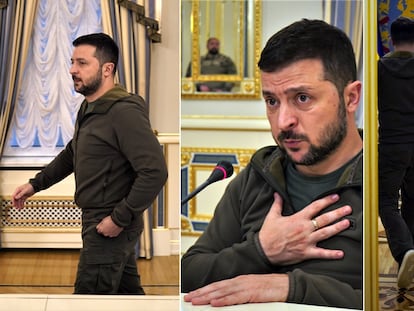What is the likelihood that Putin will launch a nuclear attack?
Experts agree that the prospect of a Russian atomic strike is remote but that the scenario caused by Ukraine’s advances on the ground is the most dangerous in decades
Vladimir Putin has repeatedly threatened to resort to nuclear weapons since the Kremlin launched its invasion of Ukraine last February. Russian setbacks on the battlefield and the weakening of Putin’s position as a result have led to heightened concern that Moscow could fall back on the nuclear option, to the extent that US President Joe Biden has described the situation as the most dangerous moment since the Cuban missile crisis of 1962 and to evoke the specter of a nuclear apocalypse.
This does not imply, however, that a Russian nuclear attack is likely. A majority of experts agree that the possibility remains remote, but they also concur with Biden’s assessment that the world is in its most delicate state in decades with unknown quantities clouding the horizon and raising the risk of an uncontrolled escalation. As such, it is increasingly important to understand the nuclear framework in which Russia is operating.
The fundamental starting point of any analysis is the destructive capacity of these weapons, which vary in scale depending on the type of bomb deployed. As a guide, below are simulations of attacks on cities such as Barcelona, Kyiv and Mexico City, carried out with warheads similar to the one dropped on Hiroshima and also the most powerful bombs Russia has in its nuclear arsenal, according to the best available analyses.
The scale of devastation would vary greatly depending on the atomic charge of the weapon - there are some nuclear devices with less potency than the Hiroshima bomb, at one kiloton – and the target city, the altitude of the detonation and weather conditions. In Kyiv, an 800-kiloton detonation would reduce almost the entire city to rubble. In Mexico City, the number of casualties would be impossible to count.
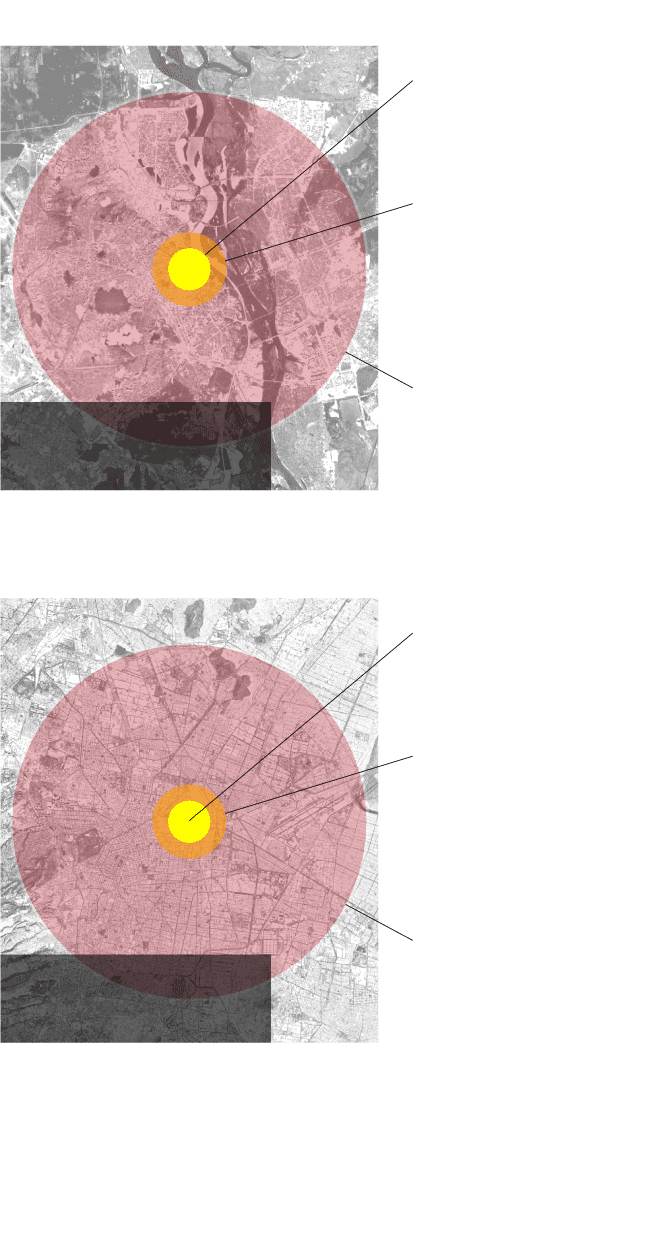
Kyiv
Fireball
Total devastation
1.2 miles
Explosion
100% fatalities
Total destruction
of buildings
2.5-mile radius
Heat radiation
Third-degree
burns
12 miles
Deaths: 280,690
Injured: 673,440
Mexico City
Fireball
Total devastation
1.2 miles
Explosion
100% fatalities
Total destruction
of buildings
2.5-mile radius
Heat radiation
Heat radiation
Third-degree
burns
12 miles
Deaths: 717.000
Injured: 1.700.000
Estimation for the first 24 hours after the launch of the bomb based on nukemap simulator (nuclearsecrecy.com).
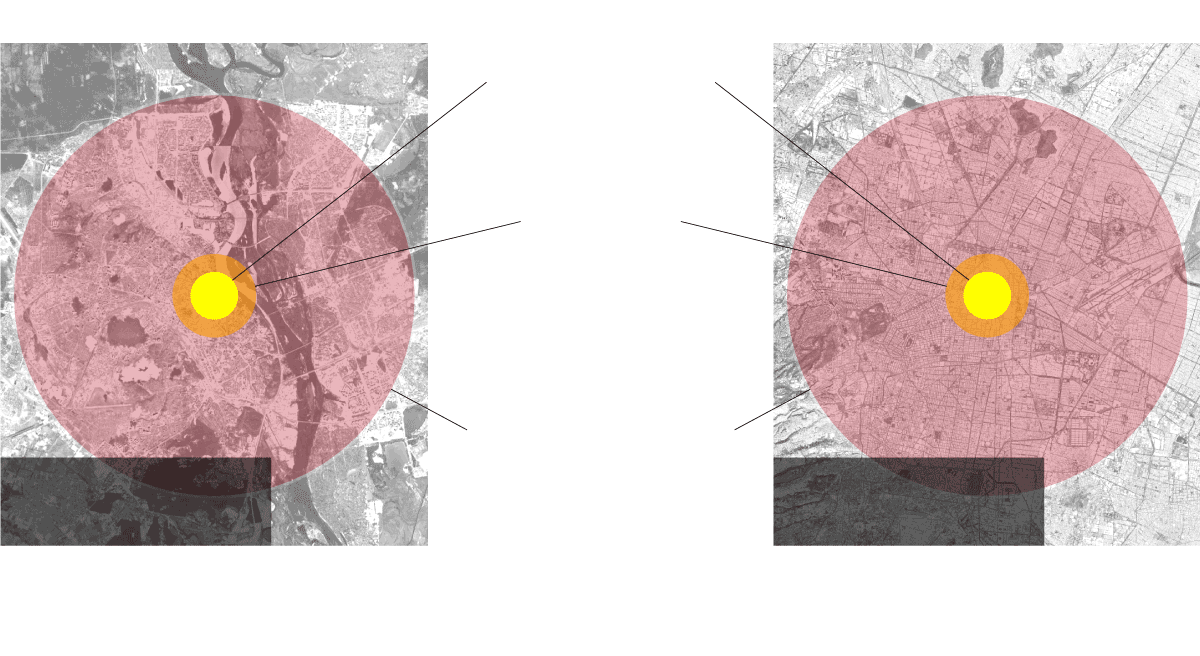
Kyiv
Mexico City
Fireball
Total devastation
2 km
Explosion
100% fatalities
Total destruction
of buildings
2.5-mile radius
Heat radiation
Third-degree
burns
12 miles
Deaths: 280,690
Heridos: 673,440
Deaths: 717.000
Injured: 1.700.000
Estimation for the first 24 hours after the launch of the bomb based on nukemap simulator (nuclearsecrecy.com).

Kyiv
Mexico City
Fireball
Total devastation
1.2 miles
Explosion
100% fatalities
Total destruction
of buildings
2.5-mile radius
Heat radiation
Third-degree
burns
12 miles
Deaths: 280,690
Injured: 673,440
Deaths: 717.000
Injured: 1.700.000
Estimation for the first 24 hours after the launch of the bomb based on nukemap simulator
This is all based on the use of a single nuclear weapon. There are nine nuclear powers in the world with a combined arsenal of over 12,000 atomic warheads. Of those, 3,730 are deployed on intercontinental missiles, long-range bomber bases or bases with a shorter range of delivery. At least 2,000 are primed for immediate use.
How likely is a nuclear attack?
The simple answer is not very. “This is the most serious nuclear threat since the end of the Cold War. But that doesn’t mean it’s likely. The risk is low”, says Hans M. Kristensen, director of the Nuclear Information Project at the Federation of American Scientists and a leading expert in the study of the arsenals of the atomic powers. “The probability of a nuclear attack remains low. Quite low, in fact”, agrees Luis Simón, director of the Elcano Royal Institute for International and Strategic Studies in Brussels and senior analyst specializing in international relations and security issues. These points of view represent the majority opinion among experts in the field.
Putin’s nuclear threats contain an eminently dissuasive logic: they are designed to cause inhibition in the West in terms of aid to Ukraine and in Kyiv, with regard to how far it is willing to push its counter-offensive against Russian troops on the ground. In the first instance Putin has achieved notable results, with Kyiv’s allies reluctant to hand over fighter jets, tanks and heavy weaponry for fear of provoking an escalation. In terms of aid, Ukraine has gained ground as its allies have stepped up their deliveries, for example with medium-range missiles. And Russia has responded with tougher threats.
The move from dissuasive threats to the reality of a nuclear attack goes against logic that, beyond wreaking a humanitarian disaster, makes such a scenario unlikely. “What would be the purpose? To push back Ukrainian gains on the ground? Nuclear weapons are not very useful for changing the situation on the battlefield,” says Kristensen.
A Russian nuclear attack designed to halt the Ukrainian counter-offensive could have three physical targets: a symbolic launch, for example in the Black Sea; an attack against Ukrainian forces; or a devastating strike against a civilian target, such as a city. The first option is unlikely to shake Kyiv’s resolve. The second faces the issue that Kyiv’s military on the ground is spread out over a wide area, which would make it an operation of little military value requiring the use of several bombs aimed at several locations, as laid out in a report by William Alberque, director of Strategy, Technology and Arms Control at the International Institute for Strategic Studies. The third, a civilian target, is practically unimaginable, due to the monstrosity of the act and the threat of international retaliation. “The more you think about it, the less logic you see in it,” says Kristensen.
Another element to take into account, beyond the destructive capacity of a nuclear explosion, is the diffusion of harmful radiation and its terrible consequences. Depending on the type of weapon used, the altitude of detonation and climate conditions, the radioactive cloud could extend over a vast area. The risk of contaminating territory Russia considers its own is considerable.
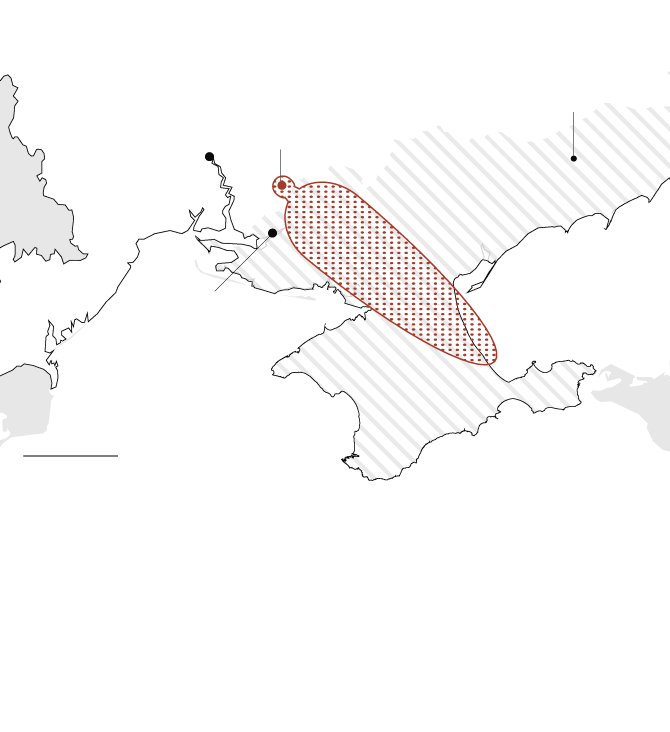
UKRAINE
Area occupied
by Russia
Nuclear explosion
Mykolaiv
Radioactive
fallout
Sea of Azov
Kherson
Crimea
62 miles
Black Sea
If an 800-kiloton nuclear bomb was dropped in Ukrainian territory, it would cause radioactive fallout for 170 miles, affecting Russian territory and areas occupied by Russia.
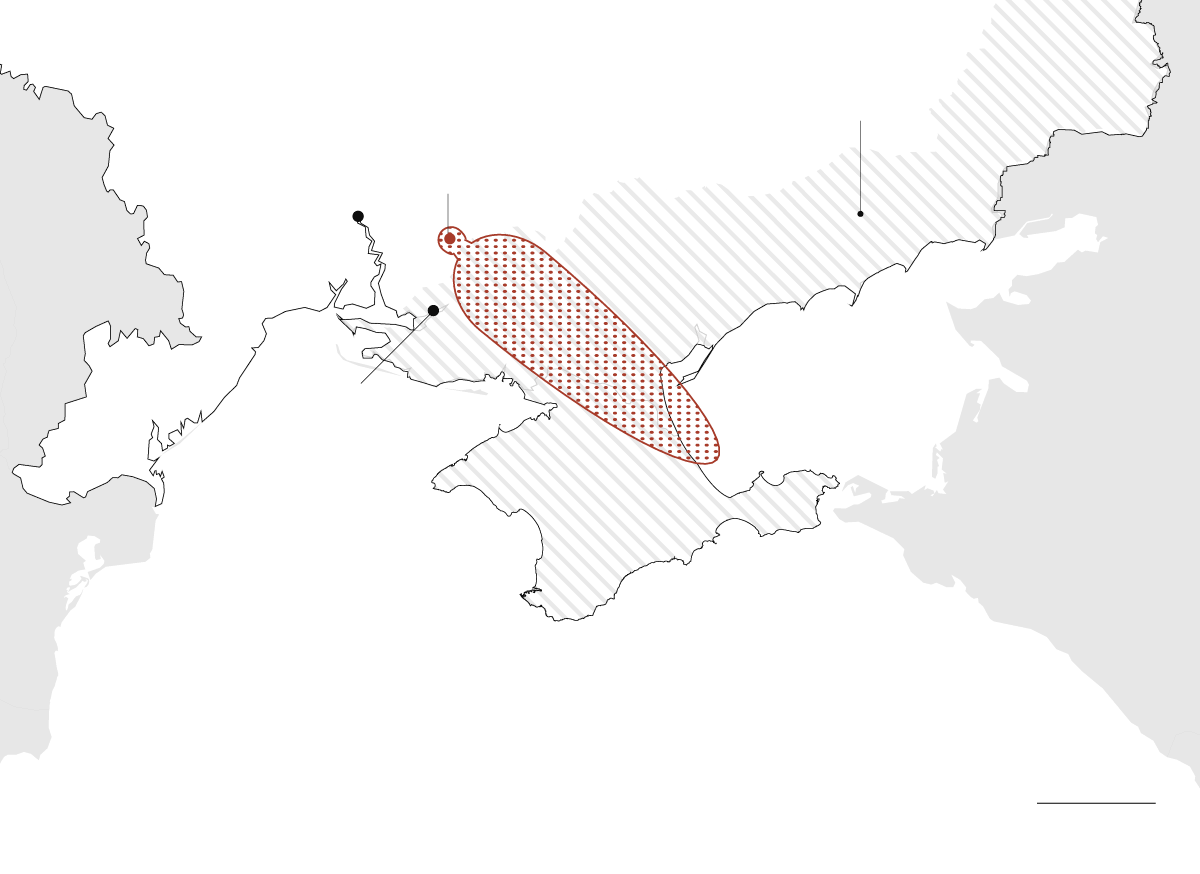
Area occupied
by Russia
UKRAINE
Nuclear explosion
Mykolaiv
Radioactive
fallout
Kherson
Sea of Azov
Crimea
Black Sea
If an 800-kiloton nuclear bomb was dropped in Ukrainian territory, it would cause radioactive fallout for 170 miles, affecting Russian territory and areas occupied by Russia.
62 miles
The possibility of retaliation is another factor. It is not easy to predict what the response to a Russian nuclear attack would be. There is a general consensus that the western Powers would not respond in kind. But the EU’s High Representative of the Union for Foreign Affairs and Security Policy, Josep Borrell, has said that there would be a conventional military response that would “annihilate” Russian forces. In any case, it is worth noting that neither the Pentagon or NATO have detected any operational movement among the Russian military that would indicate nuclear preparations on Moscow’s part.
However, neither can the threat be considered insignificant. “What increases the level of nuclear risk, which was negligible at the beginning of the invasion, is the fact that the war situation is not going well for Russia and Moscow has a lot at stake,” says Simón. “The atomic option is a very bad one, with a military sense that is not at all clear, but in Putin’s calculations it could become more attractive than another option: a military defeat that would entail geopolitical humiliation and a possible collapse of the regime. That is why the issue is on the table.” It is difficult to envisage the Kremlin passively watching an unstoppable Ukrainian advance to retake all of the territories illegally annexed by Russia. That is the scenario that is generating concern.
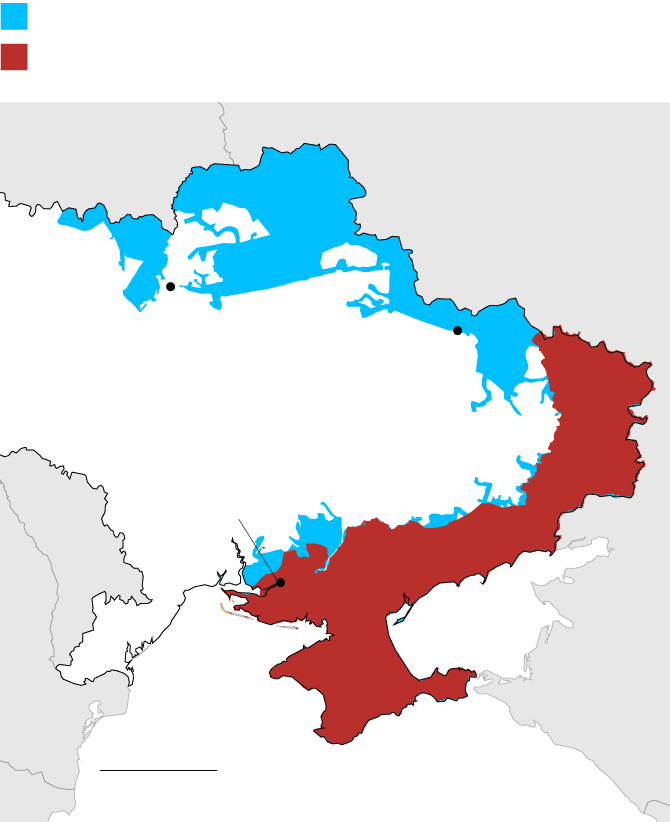
Area recovered by Ukraine since March
Area occupied by Russia
BELARUS
RUSSIA
Kyiv
Kharkiv
UKRAINE
Donbas
Kherson
Sea of Azov
Crimea
Black Sea
124 miles
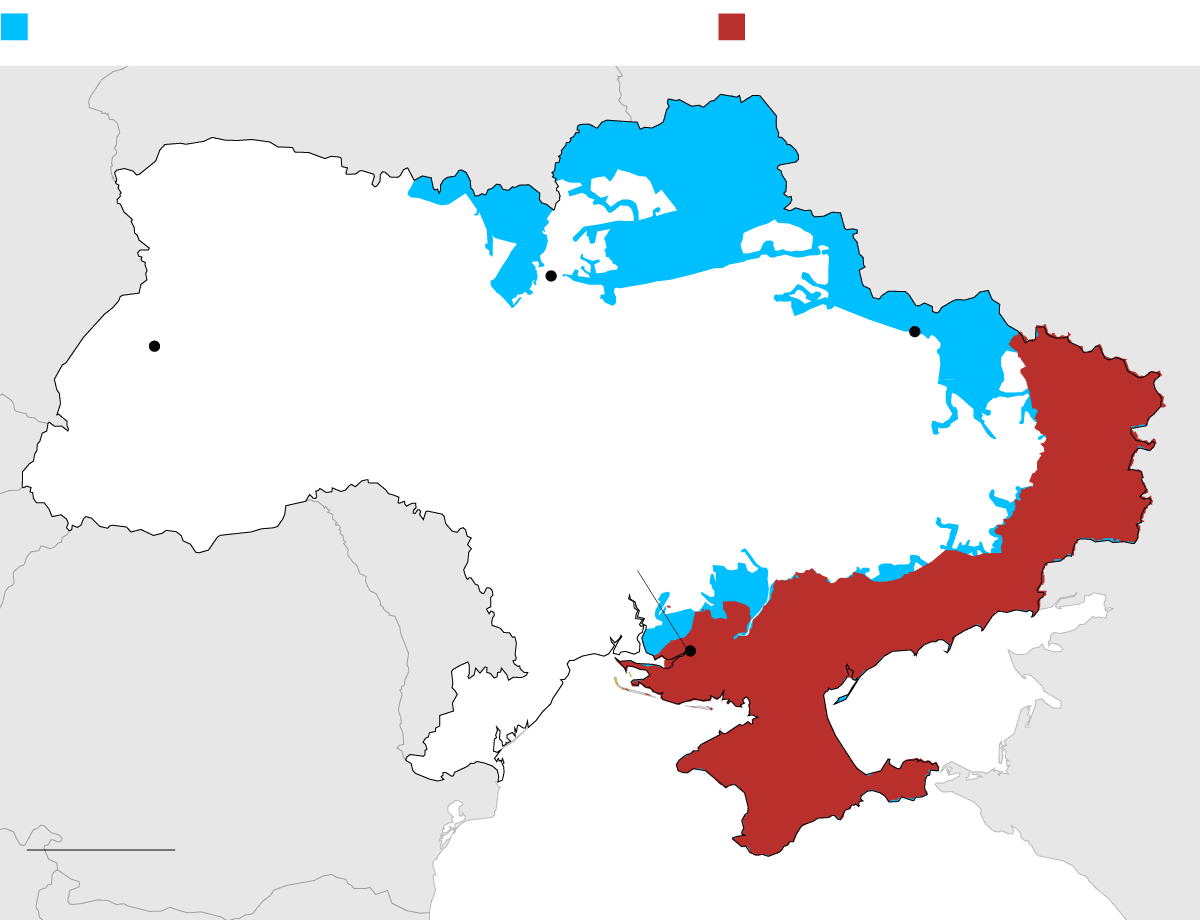
Area recovered by Ukraine since March
Area occupied by Russia
BELARUS
RUSSIA
Kyiv
Lviv
Kharkiv
UKRAINE
Donbas
Kherson
ROMANIA
Sea of Azov
Crimea
124 miles
Black Sea
“It is true that if we project that scenario to the level of a Ukraine on the verge of recapturing Crimea, the calculation is different. The Russian Black Sea fleet is based there, an element of great symbolic and strategic importance”, notes Kristensen. In such a situation it would be conceivable that the Kremlin could invoke its nuclear doctrine, laid out in a 2020 presidential decree, according to which “an aggression against the Russian Federation with conventional weapons that threatens the existence of the state” can be countered with a nuclear attack. Even in the event of a potential Ukrainian drive into Crimea, Kristensen doubts Moscow would resort to nuclear weapons, but says that such a scenario would clearly provide a more worrying prospect.
Also of concern is Putin’s rhetoric in stating that the nuclear threat is not a bluff, and the posturing of the Kremlin. The recent round of phone calls made to the defense ministers of various European powers by Russian Defense Minister Sergei Shoigu, to alert them about the potential use of a dirty bomb by Kyiv, was viewed as a pretext to justify possible future action. Subsequently, a meeting of senior Russian military personnel to discuss the nuclear option was held, according to US intelligence sources, which led a Pentagon spokesman to express his “growing unease.”
Furthermore, Russia recently carried out extensive nuclear drills and high-ranking politicians including Chechen leader Ramzan Kadyrov and former Russian President Dmitry Medvedev have explicitly called for a nuclear response in the case of continued battlefield reversals, or issued the threat using extremely direct language. As Simón notes, the dissuasive effect of international reaction is also not as definitive as it may seem. “There is talk of a conventional US military response, but I don’t see that happening. I don’t think they want to engage in a direct military confrontation, and I think Putin is counting on that.” It is noteworthy that while figures like Borrell have been explicit, the White House, the Pentagon and NATO have been considerably less so.
“In terms of China,” continues Simón, “Beijing would certainly not welcome the use of nuclear weapons, but a cornerstone of its international policy is a predictable and stable relationship with Russia. Withdrawing economic and political support from Moscow would be a serious blow, and added to the sanctions even more so. The regime would falter, and that is not in Beijing’s interest, unless it had a very clear idea about what the subsequent developments would be and that they would be in its own interest. Finally, Moscow’s relationship with the EU can hardly get any worse, so there is not much risk of added damage there.”
Kristensen also doubts both Beijing’s willingness to react harshly against Moscow and the US’s enthusiasm to directly attack Russian targets. “This option is complicated; it obviously opens the way to a war between the West and Russia. I do not see that happening. More likely, I see an intermediate, hybrid option, for example launching cyberattacks together with initiatives from the diplomatic sphere.”
Recent history also shows that Putin is willing to do things that the western powers considered unimaginable, and that when he is faced with difficulties, he does not back down but redoubles his efforts. That is why experts see the situation as being the most delicate in decades, even if the threat of a nuclear conflict remains remote.
What nuclear weapons does Putin have?
“Russia has the largest nuclear arsenal on the planet, in terms of the number of bombs and delivery methods. They have a full spectrum, from low to very high-powered atomic warheads. It is a large and flexible arsenal”, says Kristensen. Moscow has also invested huge sums to modernize its nuclear stockpile in recent decades.
The Kremlin has the ability to launch tactical and strategic warheads from silos, submarines and aircraft. Strategic warheads generally refer to those with the greatest destructive power, mounted on delivery systems with intercontinental range. Tactical warheads have a shorter range and are designed to be used on a specific battlefield, and are generally less powerful, although many tactical weapons still have a much greater destructive capacity than the bomb dropped on Hiroshima. Strategic warheads are subject to many limitations under the New START treaty between the US and Russia, while tactical warheads are not.
If Russia attacks, what nuclear weapons will it use?
In the unlikely event of a nuclear attack, experts believe the most logical choice of weapon will be a tactical device, of which Russia is estimated to have around 2,000. Moscow’s nuclear program is not transparent though, so it is difficult to gauge the precise characteristics of its arsenal.
“We don’t know for sure, but it is very likely they have tactical bombs with a capacity as low as a kiloton,” says Kristensen. The bomb dropped on Hiroshima was a 15-kiloton device. “But of course, if you decide to use a nuclear weapon, I don’t see much point in doing it with a very low-impact bomb.” Tactical weapons can pack as much as 100 kilotons. The difference in impact can be vast, depending on the model chosen.
“The conceptual difference between strategic and tactical is actually blurred, to say the least. A bomb in itself is not tactical or strategic, it is the use they are put to that makes them one or the other,” Kristensen explains. In the Ukraine war, experts believe that Russia has already used missiles with the capacity to carry nuclear warheads, such as the Kalibr, deployed by the Russian Navy, and the Iskander, which is fired from land-based systems.
What effects would a nuclear attack have?
The detonation of a nuclear device would cause various catastrophes, from radiation to the destruction caused by the fireball and the nuclear fission caused by the explosion. Obviously, there is an enormous risk that once one nuclear weapon has been fired, another nuclear power will respond, leading to a global catastrophe of unimaginable proportions, which would include not only an enormous number of direct deaths, but also terrible lethal consequences due to the effects of radiation and environmental contamination that would make agricultural and livestock farming activities difficult or impossible.
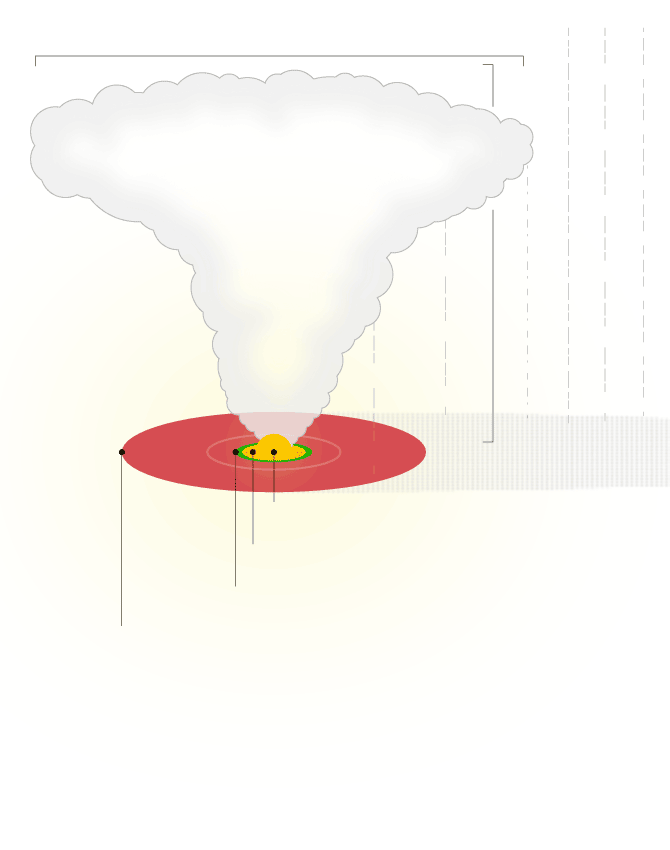
15.5 miles
Mushroom cloud
12 miles
Radioactive
fallout
(124 miles)
Fireball (1.4 miles)
Explosion (2.5 miles)
Direct radiation (3 miles)
Heat radiation (12 miles)
Estimation of the damage caused by an 800 kiloton nuclear warhead. Russia has 85 bombs (RS-12M Topol) with this nuclear charge in its arsenal.
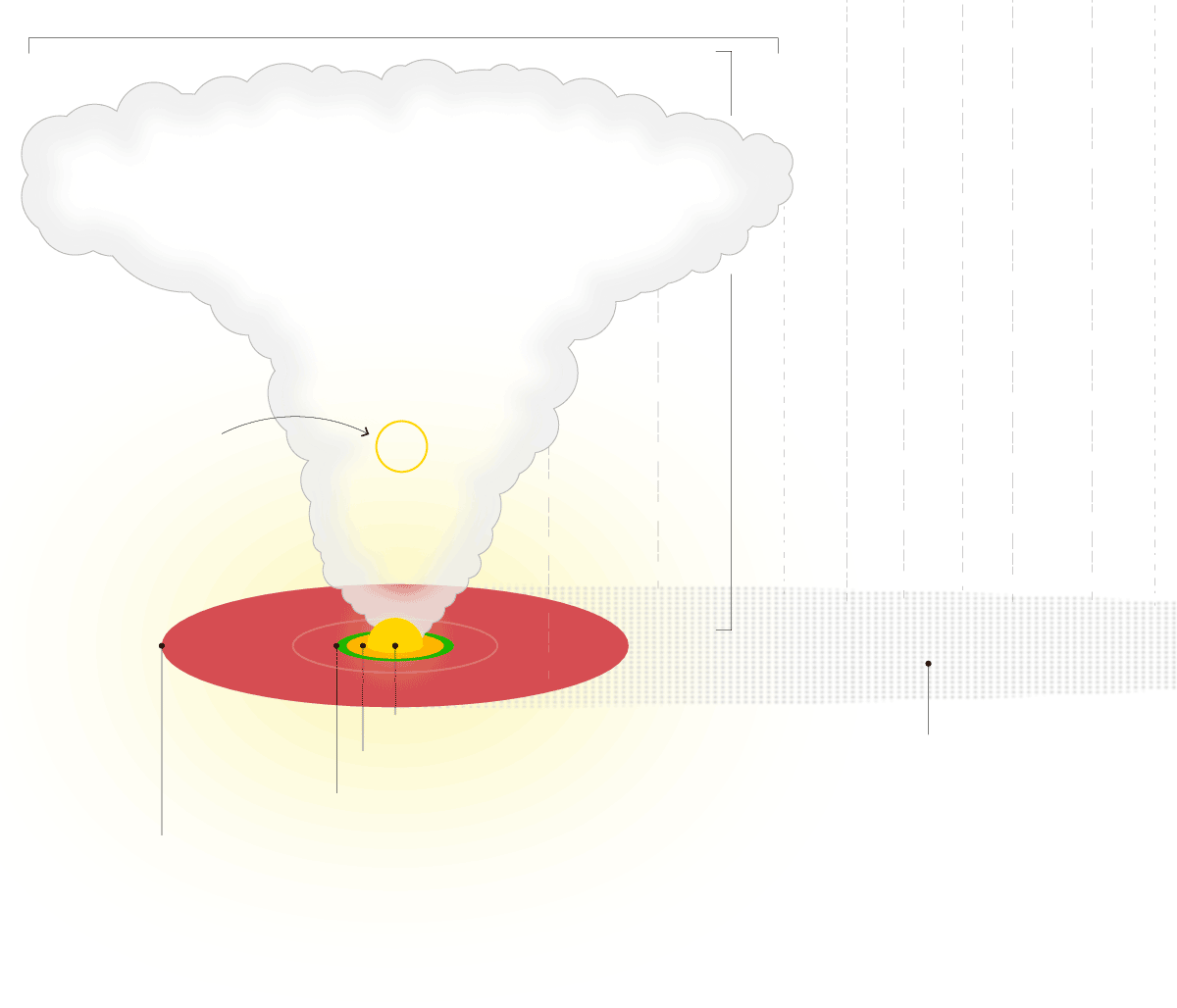
15.5 miles
Estimation of the damage caused by an 800 kiloton nuclear warhead. Russia has 85 bombs (RS-12M Topol) with this nuclear charge in its arsenal.
Mushroom cloud
12 miles
There is much
greater destruction
if the bomb detonates in the air instead of on the surface.
Fireball (1,4 miles)
Radioactive fallout is the residual, highly radioactive material that spreads after the explosion. The wind can spread lethal doses of radiation up to 124 miles away.
Explosion (2.5 miles)
Direct radiation (3 miles)
Heat radiation (12 miles)
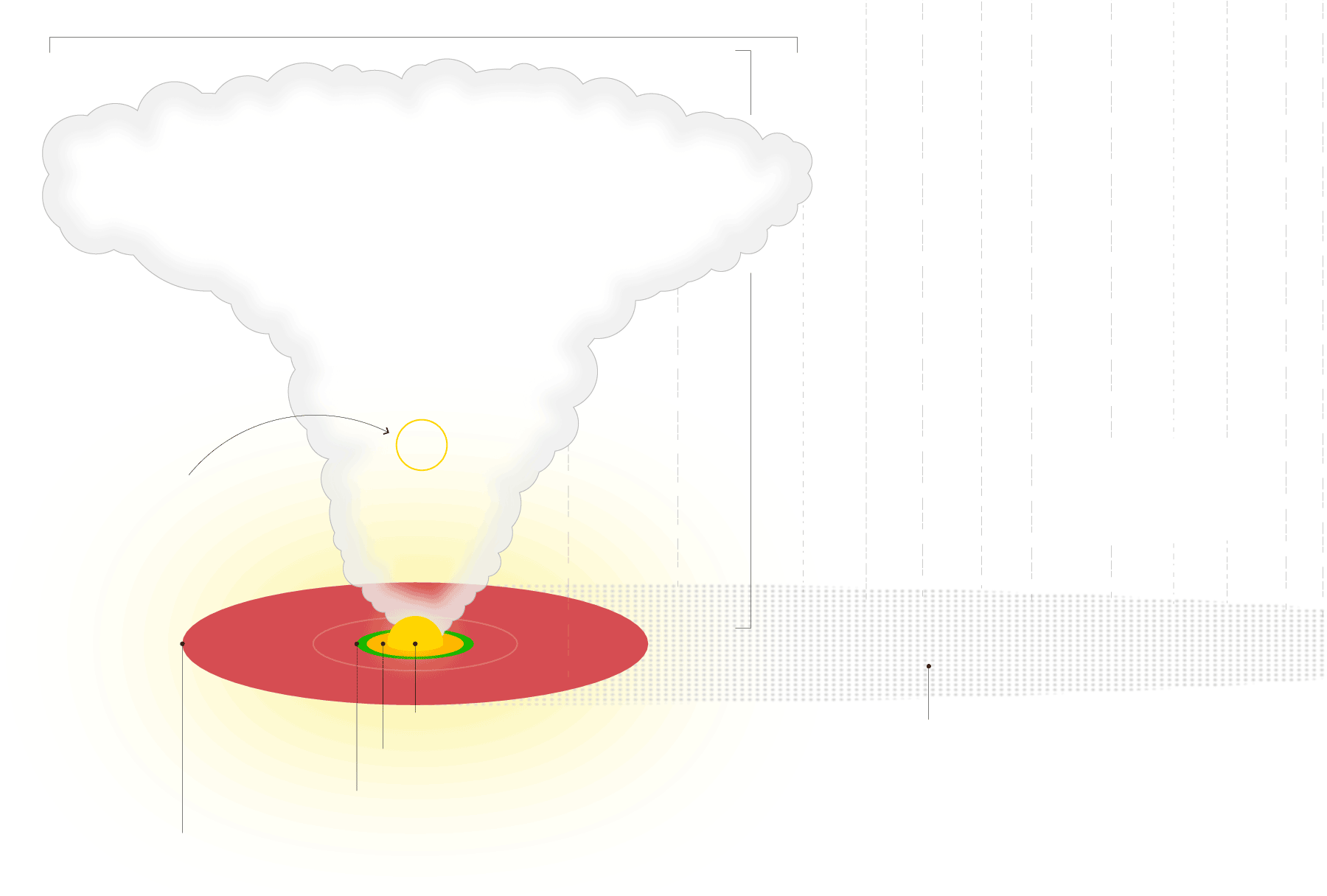
15.5 miles
Estimation of the damage caused by an 800 kiloton nuclear warhead. Russia has 85 bombs (RS-12M Topol) with this nuclear charge in its arsenal.
Mushroom cloud
12 miles
There is much
greater destruction
if the bomb detonates in the air instead of on the surface.
Fireball (1,4 miles)
Radioactive fallout is the residual, highly radioactive material that spreads after the explosion. The wind can spread lethal doses of radiation up to 124 miles away.
Explosion (2.5 miles)
Direct radiation (3 miles)
Heat radiation (12 miles)
1. Direct radiation and fireball
This is the first effect after the bomb detonates. In less than a second, everyone in a three-mile radius would receive a lethal dose of radiation. This would be followed by a 1.2-mile fireball, millions of degrees Fahrenheit in temperature. Everything within it would be evaporated.
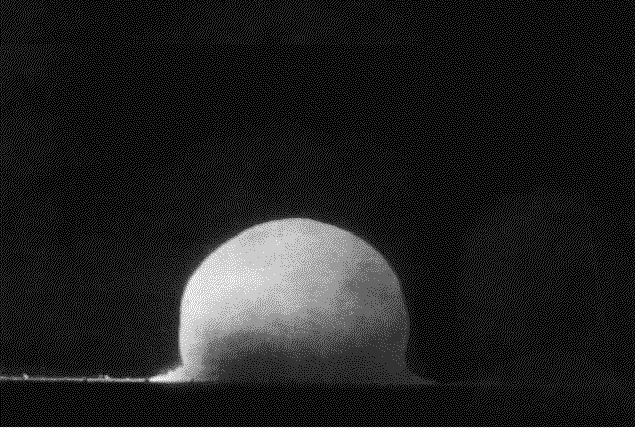 The 0.11 seconds of the first nuclear explosion on Earth: the Trinity nuclear test. (Los Alamos National Laboratory).
The 0.11 seconds of the first nuclear explosion on Earth: the Trinity nuclear test. (Los Alamos National Laboratory).
2. Explosion and heat radiation
Around the fireball, the air expands and triggers a shockwave that destroys all buildings within 2.5 miles. The destruction would be moderate after five miles, but the heat radiation would cause third-degree burns to people within a 12-mile radius.
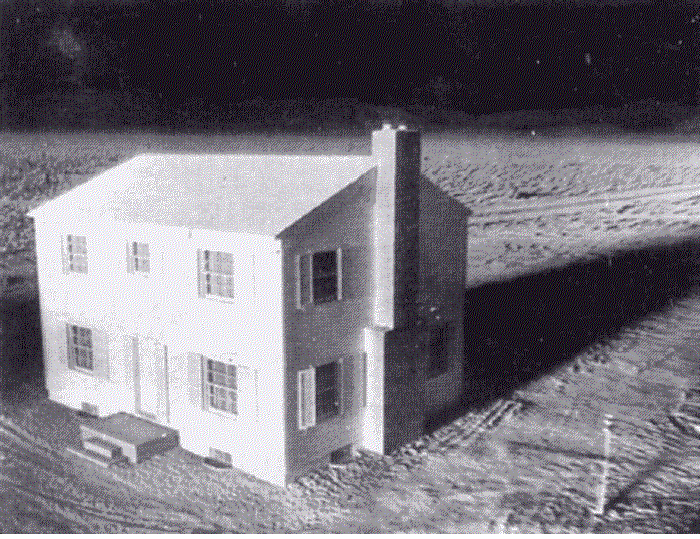 House situated 0.6 miles from ground zero of the nuclear test of the 16-kiloton bomb “Annie.” The last image was taken two seconds after the bomb detonated. (American Science Federation)
House situated 0.6 miles from ground zero of the nuclear test of the 16-kiloton bomb “Annie.” The last image was taken two seconds after the bomb detonated. (American Science Federation)
Would it be the first nuclear explosion since Hiroshima and Nagasaki?
No. Since 1945 there have been around 2,000 nuclear tests of different kinds. Around 75% of those were underground tests.
In some cases, very high-powered bombs have been detonated. In recent years the biggest nuclear powers have stopped doing tests and the only country that has been carrying them out is North Korea.

Between 1945 and 2017, more than 2,056 nuclear tests have been carried out across the world.
0.6 miles
Googlemaps
16 kilotons
656 feet
8 kilotons
426 feet
Nevada National Security Site. Just 62 miles away from Las Vegas, the US has tested hundreds of nuclear bombs here.
246 nuclear
tests
The Novaya Zemlya archipelago was one of the USSR’s main nuclear testing sites.
62 miles
Tsar bomb. 58 megatons
(equivalent of 58,000 tons of TNT)
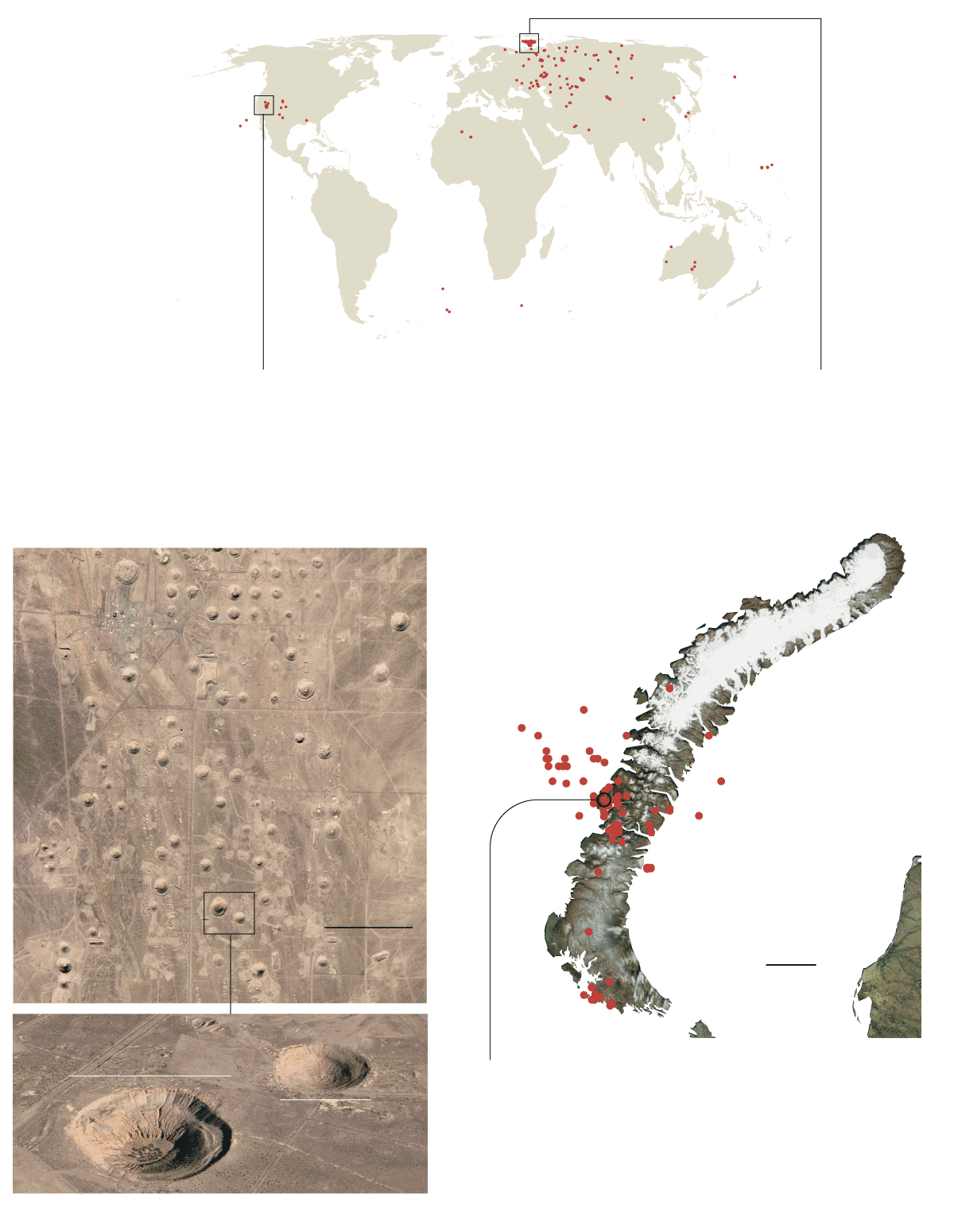
Between 1945 and 2017, more than 2,056 nuclear tests have been carried out across the world.
Nevada National Security Site. Just 62 miles away from Las Vegas, the US has tested hundreds of nuclear bombs here.
The Novaya Zemlya archipelago was one of the USSR’s main nuclear testing sites.
246 nuclear
tests
0.6 miles
62 miles
16 kilotons
656 feet
Test site of the biggest nuclear explosion in history: the Tsar bomb. It was detonated with a nuclear warhead of 58 megatons, the equivalent of 58,000 tons of TNT.
8 kilotons
426 feet
Googlemaps
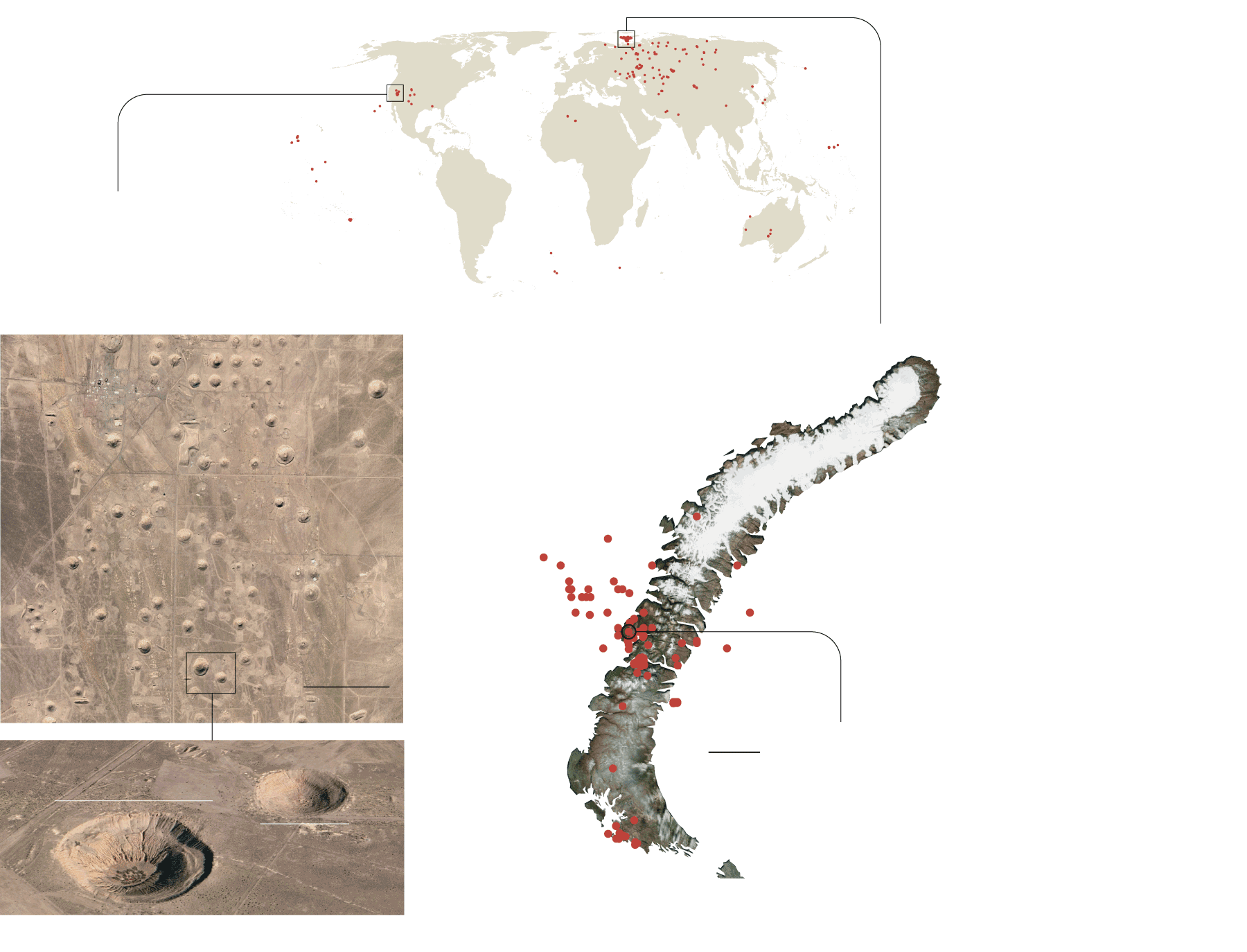
Between 1945 and 2017, more than 2,056
nuclear tests have been carried out across the world.
Nevada National Security Site. Just 62 miles away from Las Vegas, the US has tested hundreds of nuclear bombs here.
246 nuclear
tests
The Novaya Zemlya archipelago was one of the USSR’s main nuclear testing sites.
0.6 miles
62 miles
Test site of the biggest nuclear explosion in history: the Tsar bomb. It was detonated with a nuclear warhead of 58 megatons, the equivalent of 58,000 tons of TNT.
16 kilotons
656 feet
8 kilotons
426 feet
Googlemaps
Conclusion
The likelihood of Russia launching a nuclear attack is remote. But several factors linked to the war in Ukraine have raised concerns to levels not seen since the end of the Cold War. This is occurring against a general backdrop in which the major nuclear powers are investing huge sums to modernize their nuclear arsenals and, in the case of China, to expand them. Increasing geopolitical instability, and the realization that a nuclear power can invade a neighboring country without any scruples or plausible justification, has raised the specter of nuclear aggression again. “A nuclear war can never be won and must never be waged,” Ronald Reagan and Mikhail Gorbachev declared in 1985. The crystalline truth of that statement appears a little less solid today than it did then. A nuclear apocalypse is not at hand, but it is certainly closer than it has been for decades.
